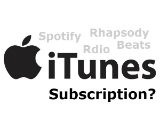The stats
In today’s market, unlike a few years ago when Steve Jobs asserted that consumers would not pay for subscription music, streaming music is the most vigorous growth segment of the U.S. music business. A report last week from the RIAA revealed 57% revenue growth of subscription streaming in 2013 over 2012, and 29% growth of ad-supported streaming in 2013 over 2012. The number of paying music subscribers in the U.S. jumped from 3.4-million to 6.1-million in 2013, according to the RIAA.
The sharp consumer uptake of streaming corresponds to uncertain trending in album and track sales. That business had a mixed year in 2013, as the RIAA documented a 3.4% revenue drop for singles, and a 2.4% revenue gain for album downloads. Apple’s iTunes Music Store is the worlds largest music retailer, selling only non-physical downloads.
iTunes Radio, Apple’s existing streaming product which started last September, provides a free listening experience supported by ads. Apple did not break out metrics for iTunes Radio in its last quarterly earnings report.
What’s in it for Apple?
As a streaming product, iTunes Radio lacks two features that could be addressed by a subscription service. The first is on-demand listening. Currently iTunes Radio operates like Pandora, its most important competitor and the market-leading Internet radio service. Both platforms enable users to “seed” a station with a band or song, but do not permit calling up an artist, song, or album directly.
The second missing feature in the iTunes lineup is subscription service — or is it? iTunes Match provides cloud storage of the user’s owned music collection, for a $25 annual fee. Google’s All Access is a similar plan, but considerably more expensive and also provides on-demand streaming of its entire catalog, which iTunes Match doesn’t provide. Presumably, Apple’s hypothetical subscription service would emulate Spotify, Rdio, and other platforms which provide free listening and enhanced features for subscribers.

